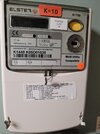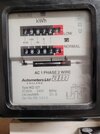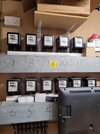I am chairman of owners' committee for timeshare development of 11 apartments. All heating is electric night storage radiators and we are on a dual rate tariff. I've recently obtained half-hour meter reports from the electricity supplier and noticed a metering/billing anomaly. The night rate period is 0000-0700 daily (I believe this is standard). When I look at the HH report, consumption in the final HH period each day (2330-2400/000 jumps significantly, clearly showing that the heaters are energised at 2330 (day rate) instead of 0000 (night rate). My question is - what switches the night-rate circuits? Is there a central time clock for the development that is on the "consumer side" or is there a time switch installed and owned by the DNO or electricity supplier?
You are using an out of date browser. It may not display this or other websites correctly.
You should upgrade or use an alternative browser.
You should upgrade or use an alternative browser.
Time control for night-rate/economy 7 tariff
- Thread starter Observer
- Start date
In the UK, there are various methods of controlling when the off-peak supply is made available. RTS [Radio Teleswitch] which is switched by a radio signal, (although these are in the process of being replaced) Smart Meters and mechanical timers, although I guess mechanical timers will have probably long gone by now. But all are controlled by the electricity supplier, otherwise occupants would be able to switch over to the cheaper rate when it suited them.
Some suppliers offered 7 hours of off-peak electricity but it can be at any time within a specified window of time, this allows them to spread the demand. Your electricity contract should specify if this is the case.
How the storage heaters are connected to the off-peak supply in the property will depend upon how they have been installed. Generally in a typical home, they are connected to a separate off-peak consumer unit at each property. This consumer unit is directly connected to the off-peak supply side of the electricity meter so the heaters are only energised when the off-peak supply is actually available.
However, your timeshare development may have something different and the heaters could be controlled from elsewhere particularly if each property doesn't have its own electric meter. If it is a separate arrangement, then it's quite possible for it to be out of sync with the off-peak tariff.
Some suppliers offered 7 hours of off-peak electricity but it can be at any time within a specified window of time, this allows them to spread the demand. Your electricity contract should specify if this is the case.
How the storage heaters are connected to the off-peak supply in the property will depend upon how they have been installed. Generally in a typical home, they are connected to a separate off-peak consumer unit at each property. This consumer unit is directly connected to the off-peak supply side of the electricity meter so the heaters are only energised when the off-peak supply is actually available.
However, your timeshare development may have something different and the heaters could be controlled from elsewhere particularly if each property doesn't have its own electric meter. If it is a separate arrangement, then it's quite possible for it to be out of sync with the off-peak tariff.
Last edited:
- Joined
- 27 Jan 2008
- Messages
- 27,430
- Reaction score
- 3,316
- Location
- Llanfair Caereinion, Nr Welshpool
- Country

As @stem points out economy 7 is a tariff not a system, in the early days we had the White meter, which supplied its own fuse box, and the storage radiators were connected to that fuse box. However this mean items like washing machines and tumble dryers could not use the cheap rate, and one could not have a boost if required.
So there has been a move to having all to one fuse box/consumer unit, an various methods to turn the items to be run over night on, the popular method was a trigger from the meter, so that the DNO could vary the times so all not switched on together, there was some form of telemetry where the radio 4 signal had triggers to start and stop night rate, and start and stop time can vary.
But there are loads of options, including smart meters, and it seem except Scotland if your not already on economy 7 you now can't get it.
So there has been a move to having all to one fuse box/consumer unit, an various methods to turn the items to be run over night on, the popular method was a trigger from the meter, so that the DNO could vary the times so all not switched on together, there was some form of telemetry where the radio 4 signal had triggers to start and stop night rate, and start and stop time can vary.
But there are loads of options, including smart meters, and it seem except Scotland if your not already on economy 7 you now can't get it.
Could you post a photo or 2 of the incoming meter(s) etc?
Sounds like the off peak isn't being controlled by the supply meter so there could be a timer / contactor involved
Sounds like the off peak isn't being controlled by the supply meter so there could be a timer / contactor involved
This is the supply meter.Could you post a photo or 2 of the incoming meter(s) etc?
Sounds like the off peak isn't being controlled by the supply meter so there could be a timer / contactor involved
Attachments
Couple more pics:Could you post a photo or 2 of the incoming meter(s) etc?
Sounds like the off peak isn't being controlled by the supply meter so there could be a timer / contactor involved
1. Supply meter location
2. Bank of sub-meters used to recharge weekly consumption to owners/occupiers.
3. Close-up of one sub-meter
With regard to 2, I presume that the 'low' and 'normal' registers of the sub-meters are separately wired to the 'day' and 'night' circuits at each apartment's CU.
Attachments
Eric, you've said that several times recently, but where does it come from?But there are loads of options, including smart meters, and it seem except Scotland if your not already on economy 7 you now can't get it.
It seems odd that the situation would be different in Scotland and the rest of the UK, since I thought (maybe wrongly?) that people in Scotland were free to 'switch' to any of the suppliers used by English customers, and vice versa. Is that not the case?
Kind Regards, John
... and also 'dumb' (but electronic) meters, like mine. As I've said before, I can but assume that my meter is relying onn an internalclock (although I presume it then must have a backup batter {or large capacitor} to keep thee clock going during power cuts and during periods when the service fuse has been pulled for maintenance).In the UK, there are various methods of controlling when the off-peak supply is made available. RTS [Radio Teleswitch] which is switched by a radio signal, (although these are in the process of being replaced) Smart Meters and mechanical timers,
Hmmm. "Long gone" is one of those 'absolute' words like 'none', 'all', 'always', 'never', 'everyone' and 'no-one' which, in the real world is 'almost never' (although I guess mechanical timers will have probably long gone by now.
I think that the great majority of people with E7 (or similar) tariffs these days have the 'modern' situation of the dual-tariff metering/charging applying to all electricity used within the installation. When that's the case, there will not be a separate 'off-peak supply', so that switching of storage heaters has to be achieved with some sort of local contactor/relay (a switching supply for which may be available from the meter).How the storage heaters are connected to the off-peak supply in the property will depend upon how they have been installed. Generally in a typical home, they are connected to a separate off-peak consumer unit at each property. This consumer unit is directly connected to the off-peak supply side of the electricity meter so the heaters are only energised when the off-peak supply is actually available.
Kind Regards, John
... and also 'dumb' (but electronic) meters, like mine. As I've said before, I can but assume that my meter is relying onn an internalclock (although I presume it then must have a backup batter {or large capacitor} to keep thee clock going during power cuts and during periods when the service fuse has been pulled for maintenance).
Hmmm. "Long gone" is one of those 'absolute' words like 'none', 'all', 'always', 'never', 'everyone' and 'no-one' which, in the real world is 'almost never' () true
I think that the great majority of people with E7 (or similar) tariffs these days have the 'modern' situation of the dual-tariff metering/charging applying to all electricity used within the installation. When that's the case, there will not be a separate 'off-peak supply', so that switching of storage heaters has to be achieved with some sort of local contactor/relay (a switching supply for which may be available from the meter).
Kind Regards, John
so that switching of storage heaters has to be achieved with some sort of local contactor/relay (a switching supply for which may be available from the meter).
Am I correct in thinking that would be the case in a typical residential context but where the meter is a HH meter then no switching (to a night rate circuit) is needed because the meter will record day and night rate consumption?
What do you mean by "HH" and "HH meter"?Am I correct in thinking that would be the case in a typical residential context but where the meter is a HH meter then no switching (to a night rate circuit) is needed because the meter will record day and night rate consumption?
The meter will, as you say, separately record the day and night consumption,. However, if you want the storage heaters to only use electricity during the night-time ('cheap') period, then something has to switch them off during thee 'day' (and 'on' during the 'night').
Kind Regards, John
The HHR heaters have 2 supplies, one for the Off Peak supply and the other for control and Top-up during peak if required, however they usually include a timer facility and WiFi control. They are quite capable of running on a single permanent supply and heat during the Off Peak hours.Am I correct in thinking that would be the case in a typical residential context but where the meter is a HH meter then no switching (to a night rate circuit) is needed because the meter will record day and night rate consumption?
No, those are 4 wire meters and just switch to one register or the other, so whatever is used is either at the day rate or the night rate. They do not have any load switching capabilities.I presume that the 'low' and 'normal' registers of the sub-meters are separately wired to the 'day' and 'night' circuits at each apartment's CU.
There are either timeclocks at each apartment, or a central one which switches the storage heaters via individual contactors. Possibly in one of the grey cabinets where the modern meter is.
That metering room is not a suitable location to store items, those batteries, television, cardboard box on a shelf, the shelf itself and whatever else is in there needs to be removed.
Fair enough, but ...The HHR heaters have 2 supplies, one for the Off Peak supply and the other for control and Top-up during peak if required,
... from what I understand, a 'single permanent supply' (with dual tariff metering) is probably what the OP has. If the heaters contain timers, then that would be fine for thee op, but the timers (I presume one for each and every heater?) would all to be correctly set to correspond with the 'off-peak' periods of thee tariff/metering (and, unless they had battery back-up, might all have to be re-set in the event of a power cut or other interruption of the supply to them)..however they usually include a timer facility and WiFi control. They are quite capable of running on a single permanent supply and heat during the Off Peak hours.
Kind Regards, John
Yes exactly on all 3 points with backup... from what I understand, a 'single permanent supply' (with dual tariff metering) is probably what the OP has. If the heaters contain timers, then that would be fine for thee op, but the timers (I presume one for each and every heater?) would all to be correctly set to correspond with the 'off-peak' periods of thee tariff/metering (and, unless they had battery back-up, might all have to be re-set in the event of a power cut or other interruption of the supply to them)..
Kind Regards, John
- Joined
- 25 Apr 2016
- Messages
- 2,819
- Reaction score
- 682
- Country

Check the timing statements - is the timing in BST or GMT?I am chairman of owners' committee for timeshare development of 11 apartments. All heating is electric night storage radiators and we are on a dual rate tariff. I've recently obtained half-hour meter reports from the electricity supplier and noticed a metering/billing anomaly. The night rate period is 0000-0700 daily (I believe this is standard). When I look at the HH report, consumption in the final HH period each day (2330-2400/000 jumps significantly, clearly showing that the heaters are energised at 2330 (day rate) instead of 0000 (night rate). My question is - what switches the night-rate circuits? Is there a central time clock for the development that is on the "consumer side" or is there a time switch installed and owned by the DNO or electricity supplier?
DIYnot Local
Staff member
If you need to find a tradesperson to get your job done, please try our local search below, or if you are doing it yourself you can find suppliers local to you.
Select the supplier or trade you require, enter your location to begin your search.
Please select a service and enter a location to continue...
Are you a trade or supplier? You can create your listing free at DIYnot Local
Similar threads
- Replies
- 35
- Views
- 25K




